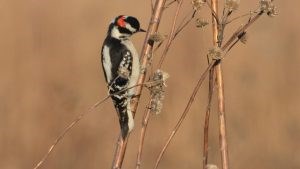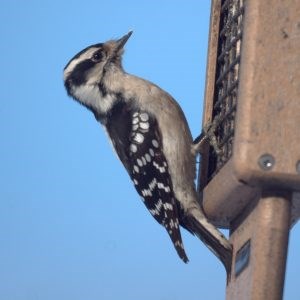This content was originally published by the Longmont Observer and is licensed under a Creative Commons license.
Out of the corner of my eye, I catch movement. There, on the trunk of a tree is a little black and white bird with a bright red spot on its head. It’s a downy woodpecker. The father of taxonomy, Carl Von Linnaeus, named the bird without ever having seen it. It was named based on the description of an American scientist, Mark Catesby, who gave the bird its common name because of the soft white feathers on its back. The smallest of the North American woodpeckers, it can be found throughout the United States. The downy woodpecker has been relatively well-studied due to some of its foraging habits which I’ll describe.
Barely larger than a chickadee, the downy woodpecker has a short bill that is no longer than the length of its head. Downy woodpeckers are white on their bellies and black and white checked on the wings. Their backs have a white stripe running down the length of the body. The heads are black and white striped, and males have a red spot on the back of their head. Total body length is 5-6.5 inches and the body weight is less than one ounce. Downy woodpeckers are often confused with the hairy woodpecker, but downy woodpeckers are smaller in size and have a shorter, stubbier bill than the hairy woodpecker.

Downy woodpeckers can be found in open woodlands, particularly along streams. However, this is a very versatile bird and it can also be found in the city at backyard bird feeders. Downy woodpeckers tend to prefer deciduous trees.
Insects make up the majority of the downy woodpecker’s diet. This includes beetle larvae that live inside tree bark, ants, and caterpillars. Economically, downy woodpeckers play an important role by eating pest species such as corn earworms, tent caterpillars, bark beetles, and apple borers. They will also eat plant materials such as berries, acorns, and grains which account for about a quarter of their diet. As mentioned, downy woodpeckers can also be found frequenting backyard bird and suet feeders, and they particularly like black oil sunflower seeds.

They are very acrobatic birds and can even feed upside down. Downy woodpeckers forage primarily on trees, but will also forage on shrubs and weed stalks. Males and females each have their own feeding niche which has been extensively studied. Males tend to forage mostly on preferred areas such as small branches and weed stems whereas females tend to forage more on larger branches and tree trunks. When researchers removed males from a woodlot, females responded by feeding on smaller branches indicating males kept females from preferred feeding sites.
Downy woodpeckers occur in flocks of mixed bird species in the winter. This is thought to allow them to spend less time watching for predators and give them more success in finding food. In winter, downy woodpeckers spend more time tapping and excavating food and, in the summer, they spend more time feeding on surfaces.
Pairs form in late winter. Courtship displays include what is known as the “butterfly flight.” Males and females will chase each other with the wings held high, flapping them slowly like a butterfly. Pairs appear to be monogamous for the duration of the nesting season.
Nest sites are chosen by either member of the pair, although females tend to choose a site more often than the male. Downy woodpeckers usually choose trees that are either dead or have limbs with advanced heartrot for nesting which makes it easier to excavate the nest.
Nests are typically located on a limb that is about seven inches in diameter. The tree limb leans away from the vertical and the entrance hole is placed on the underside of the limb. Excavating the nest takes between one and three weeks and is done by both the male and the female. The entrance to the nest is 1-1.5 inches in diameter. The nest cavity is 6-12 inches deep and is lined by wood chips. Nest sites are not reused from year to year.

Females lay between three and eight eggs with the average being four or five. Only one clutch of eggs is laid per season. Both sexes incubate the eggs and they hatch after 12 days. Nestlings are hatched naked and with closed eyes. Both sexes will bring insects to the nest to feed the young. About 20 days after hatching, the young leave the nest. The young may follow the parents around for a few weeks before striking off on their own.
Downy woodpeckers can be recognized by their pattern of flight. They tend to fly in an undulating pattern, alternating quick wingbeats with holding their wings against their bodies. In the winter, look for them in mixed flocks of birds. Both sexes will drum on trees to announce their presence. Downy woodpeckers have two characteristic calls: a whinnying call and a pik call. You can also attract these birds by putting out suet feeders and black oil sunflower seeds, peanuts, millet, and chunky peanut butter. These are charming little acrobats that are fun to watch!


